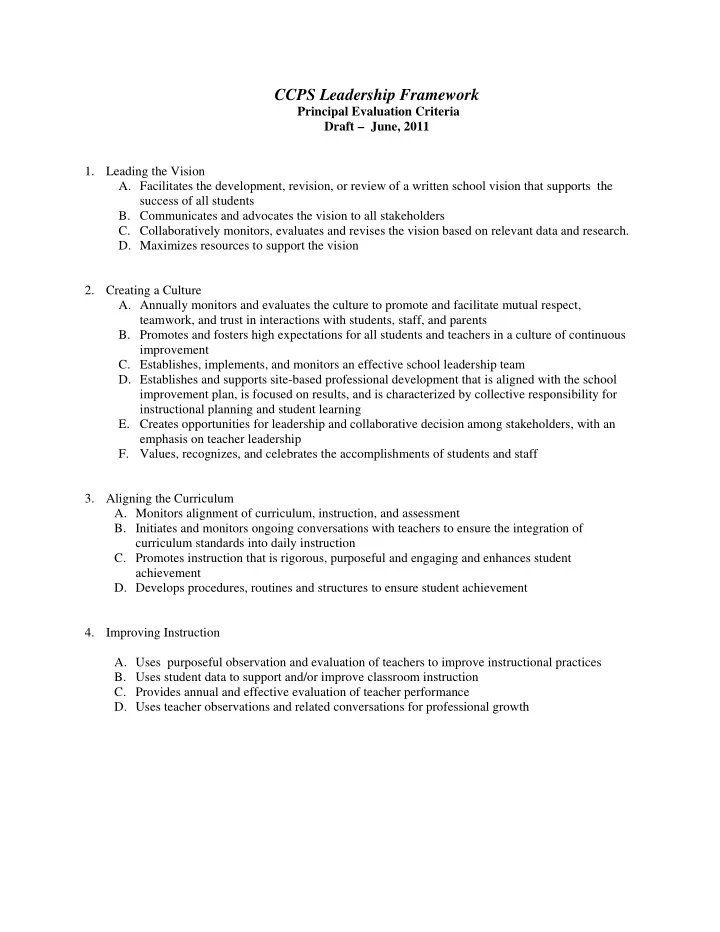

CCPS Leadership Framework Principal Evaluation Criteria Draft – June, 2011 1. Leading the Vision A. Facilitates the development, revision, or review of a written school vision that supports the success of all students B. Communicates and advocates the vision to all stakeholders C. Collaboratively monitors, evaluates and revises the vision based on relevant data and research. D. Maximizes resources to support the vision 2. Creating a Culture A. Annually monitors and evaluates the culture to promote and facilitate mutual respect, teamwork, and trust in interactions with students, staff, and parents B. Promotes and fosters high expectations for all students and teachers in a culture of continuous improvement C. Establishes, implements, and monitors an effective school leadership team D. Establishes and supports site-based professional development that is aligned with the school improvement plan, is focused on results, and is characterized by collective responsibility for instructional planning and student learning E. Creates opportunities for leadership and collaborative decision among stakeholders, with an emphasis on teacher leadership F. Values, recognizes, and celebrates the accomplishments of students and staff 3. Aligning the Curriculum A. Monitors alignment of curriculum, instruction, and assessment B. Initiates and monitors ongoing conversations with teachers to ensure the integration of curriculum standards into daily instruction C. Promotes instruction that is rigorous, purposeful and engaging and enhances student achievement D. Develops procedures, routines and structures to ensure student achievement 4. Improving Instruction A. Uses purposeful observation and evaluation of teachers to improve instructional practices B. Uses student data to support and/or improve classroom instruction C. Provides annual and effective evaluation of teacher performance D. Uses teacher observations and related conversations for professional growth
5. Planning with Data A. Provides leadership in developing, implementing and evaluating the school improvement plan B. Reviews and shares disaggregated data periodically to monitor progress and drive instructional decision making C. Makes instructional decisions based on careful and thorough analysis of student performance and the underlying root causes D. Supports regular collaboration among teachers for analyzing student work, progress monitoring, and strategic planning. 6. Building Capacity A. Provides differentiated professional development based on the needs of the staff and linked to school improvement B. Provides standards-based and results oriented professional development that is aligned with identified curricular, instructional, and assessment needs. C. Provides opportunities for teachers to engage in collaborative planning and job-embedded professional development D. Identifies and provides professional development for potential and current school leaders 7. Involving the Community A. Demonstrates that parents and caregivers are welcomed in the school, encouraged to participate, and given resources to help their children learn B. Demonstrates that parents and caregivers are active members of the school improvement process C. Demonstrates that community stakeholders and school partners readily participate in school life D. Models a respect for diversity and is sensitive to the needs within the school community 8. Managing Personal and Professional Resources A. Makes staffing decisions that maximize and promote student success B. Maintains a safe, healthy, and orderly learning environment C. Works within policies, laws, and regulations D. Models mutual respect, teamwork, and trust in dealings with students, staff, and parents E. Seeks ways to improve professional skills and knowledge
CCPS Leadership Framework Indicator Rubrics Domain 1: Leading the Vision Leaders are future focused and can communicate a shared vision that provides members with a compelling purpose or mission for their work. The vision becomes the driving force for productive and meaningful change. INDICATOR UNSATIFACTORY BASIC PROFICIENT DISTINGUISHED 1.A. Facilitates the A written vision does not exist. A vision exists however it is not The written vision …and development, revision, or current and has not been reviewed communicates a commitment to The written vision is a review of a written school or is not used to guide school-based high expectations for student compelling image of a learning vision that supports the success decisions success in a diverse and global community that reflects the of all students community highest standards for excellence and achievement 1.B. Communicates and The vision is communicated by The vision is communicated by the Staff connect instruction and …and advocates the vision to all the principal but not articulated principal and articulated by staff decision making to the vision The school community is stakeholders to ensure by staff members but there is limited connection to on a regular basis actively involved in supporting articulation within the entire instructional decisions and practices the school’s vision school community 1.C. Collaboratively monitors, There is minimal evidence of Data is shared and used with limited Data is used to gain shared …and evaluates and revises the vision data used to support the vision. connections made to the school commitment for the success of Data is used to promote based on relevant data and vision. the vision. Collaborative ownership of a compelling research. processes are designed and instructional vision. Long and implemented to collect and short term goals are measurable monitor progress. and set to achieve the vision. 1.D. Maximizes resources to There is minimal evidence that At times, resource allocations All decisions ensure the …and support the vision decisions regarding resources support the vision, but the strategic allocation of resources Feedback and data are used to are aligned to the vision. alignment to the vision is not including budget, staffing, assess the success of funding consistent. professional development and and resource decisions. instruction to meet goals that align to the vision
Recommend
More recommend